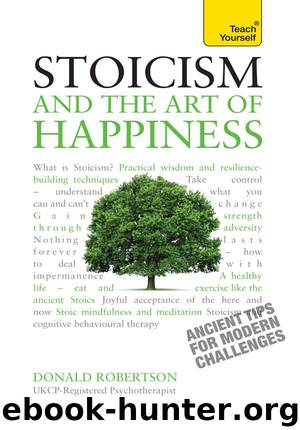Stoicism and the Art of Happiness - Ancient Tips For Modern Challenges: Teach Yourself by Donald Robertson

Author:Donald Robertson
Language: eng
Format: epub, pdf
Publisher: Hodder & Stoughton
Published: 2013-12-27T00:00:00+00:00
Epictetus therefore says that people can only truly be friends, and love one another, if they place their self-interest primarily in the wellbeing of their own character or volition, through the cultivation of wisdom, justice and the other virtues. Nevertheless, when we desire, first and foremost, to become just, fair and benevolent ourselves, in all of our relationships, we implicitly also wish others to flourish.
Key idea: Friendship and beauty in Stoicism
Zeno’s ideal Stoic Republic was composed of Sages who lived in friendship and harmony with one another. The words used for ‘friendship’ also mean ‘love’ or ‘affection’ between friends, and intimate friendship appears to have been the purpose even of sexual love in Stoicism. Zeno also said that only perfect Sages are capable of true friendship and non-Sages are bound to be enemies. However, it’s not clear if he meant this to be taken literally, as Stoics typically considered friendship, albeit of an imperfect sort, to be within our grasp and worth cultivating. Neither Zeno nor his successors claimed to be Sages, but they clearly didn’t think of themselves as the enemies of their students! Anyway, Stoics certainly believed that it was important to emulate the ideal Sage, who exhibits love and friendship towards others.
The majority of people pursue friendship for mutual advantage, in terms of ‘indifferent’ things such as wealth or reputation but this is not the true friendship of the wise. Having friends around you is a ‘preferred indifferent’, naturally valued for its own sake but beyond our direct control. However, friendship in the truest sense means being yourself a friend towards other people because they deserve your friendship rather than for some ‘external’ advantage. Seneca actually says the Sage wants to have friends, although content and self-sufficient without one, mainly so he can exercise the virtues of friendship himself, in the relationship. However, gaining friends who reciprocate your affection, is described by Cicero’s ‘Laelius’ as second in importance only to being wise and good, suggesting he views it as the most valuable of all ‘preferred indifferents’. Stoics therefore seek to acquire wise and good friends (and mentors) for themselves, presumably with the caveat ‘fate permitting’.
According to the early Stoics, ‘the good’ (agathos) is also (kalos), which can mean either ‘beautiful’ or ‘honourable’ in Greek. For Stoics, these are virtually synonymous anyway because they consider the essence of human beauty to be virtue, rather than one’s external appearance. Likewise, Xenophon said that Socrates frequently joked about the mutual love between himself and his close circle of friends but that ‘anyone could see that what attracted him was the state of being gifted not with physical beauty but with excellence of mind and character’ (Memorabilia, 4.1).
We consider each thing to be ‘beautiful’ in a way that’s most appropriate to its nature: what makes a horse beautiful is different from what makes a necklace beautiful. When humans excel in terms of their essential nature, as rational animals, we make ourselves beautiful in the true sense, whereas folly and vice make us ‘ugly’ characters.
Download
Stoicism and the Art of Happiness - Ancient Tips For Modern Challenges: Teach Yourself by Donald Robertson.pdf
This site does not store any files on its server. We only index and link to content provided by other sites. Please contact the content providers to delete copyright contents if any and email us, we'll remove relevant links or contents immediately.
The Four Agreements by Don Miguel Ruiz(6313)
Flow by Mihaly Csikszentmihalyi(4488)
The Four Tendencies by Gretchen Rubin(4423)
You Do You by Sarah Knight(4326)
Adulting by Kelly Williams Brown(4232)
The Hacking of the American Mind by Robert H. Lustig(4082)
A Simplified Life by Emily Ley(3966)
Right Here, Right Now by Georgia Beers(3913)
Ikigai by Héctor García & Francesc Miralles(3889)
The Power of Positive Thinking by Norman Vincent Peale(3858)
The Art of Happiness by The Dalai Lama(3844)
The Little Book of Hygge by Meik Wiking(3443)
The French Women Don't Get Fat Cookbook by Mireille Guiliano(3410)
The Heroin Diaries by Nikki Sixx(3317)
Why Buddhism is True by Robert Wright(3281)
The Courage to Be Disliked by Ichiro Kishimi & Fumitake Koga(3253)
The Choice by Edith Eva Eger(3211)
Spark Joy by Marie Kondo(3087)
Make Your Bed by William H. Mcraven(2987)
